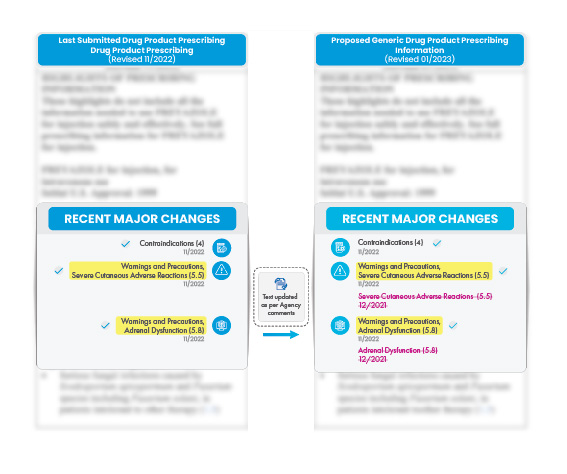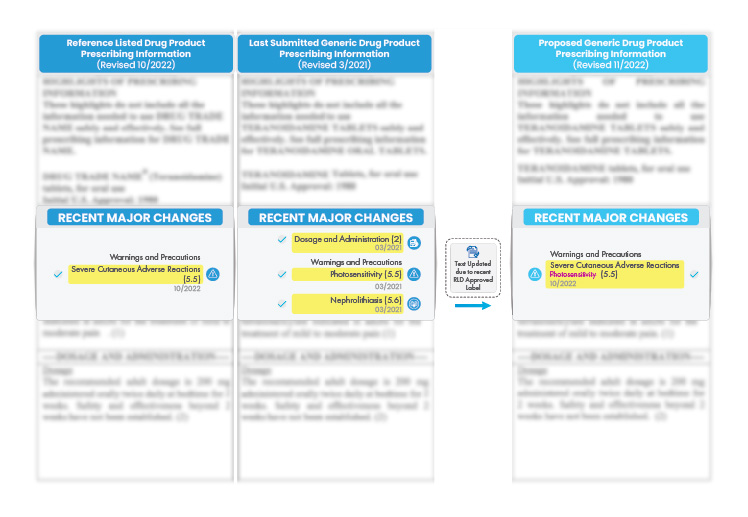
The annotated labeling document is a Regulatory requirement that needs to be submitted along with New Drug Applications (NDAs)/Abbreviated New Drug Applications (ANDAs)/new Marketing Authorization Applications (MAAs). This blog will give you an overview of the requirements for developing an annotated labeling package.
Annotated Labeling Documentation Requirements for Drug Applications: Innovator, Generic, and Subsequent Submissions
- For innovator drug applications, the annotated document will provide an explanation to the health authority reviewers from which the labeling content is derived or sourced. The references/supportive documents are mainly from (but not limited to) clinical, non-clinical, and quality modules.
- In the case of generic drug submissions, the annotations will explain the changes against the innovator’s label and provide the justification for the changes. For subsequent submissions, the annotated labeling documents will have to explain the changes from the initial submissions, how the existing text has changed, and the rationale behind the changes.
- For initial innovator submissions, the references should be annotated to the respective module sections and clinical study report numbers in the same labels.
- For subsequent submissions, changes from initial submissions and HA comments should be explained using the track change mode or two (02)-way side-by-side comparisons.
SIDE-BY-SIDE LABELING COMPARISON OF PACKAGE INSERTS (2-Way Comparison)

- For initial generic submissions in the United States (US), changes from the reference labels need to be provided with two (02)-way side-by-side comparisons, and the changes should be highlighted either with track changes or text highlights.
- For subsequent reference label change submissions, the changes must be explained in either two (02)-way (innovator versus proposed generic label text) or three (03)-way (innovator versus approved generic label text versus proposed generic label) side-by-side comparisons.
SIDE-BY-SIDE LABELING COMPARISON OF PACKAGE INSERTS (3-Way Comparison)

- For generic submissions in Europe, changes from innovator labels or the last-submitted labels must be presented in the track change mode to enable a simplified review process.
- For other semi-regulated markets, HAs may request for the submission of side-by-side comparisons, with innovator versus approved regulated market labeling text versus proposed respective country labeling text for smooth review and comparison, and in turn, faster approvals.
Conclusion
Submitting the annotated labeling document to the HA, along with every initial and following submission is important. Failure to comply with the requirements will result in a refusal of the application or receiving a request/deficiency letter from the HA.
Thus, due diligence should be done while preparing these documents as part of every submission process. By ensuring that all relevant label information is provided with annotations at each stage of the review process – from the initial submission to subsequent updates – manufacturers can ensure that their products meet the required standards quickly and efficiently while avoiding unnecessary delays caused by insufficient document submission on the first attempt.
The development of a specific and precise annotated labeling document for any Regulatory submission package requires thorough understanding, experience, and knowledge of the dossier and Regulatory labeling writing.
Freyr is a significant achiever in dossier writing and has vast experience and expertise in the field, with a team of highly qualified labeling writing professionals. Together, our experts have developed and supported numerous NDA/ANDA/MAA labeling submissions and are well-versed in dealing with submissions to the United States Food and Drug Administration (USFDA), European Medicines Agency (EMA), Medicines and Healthcare Products Regulatory Agency (MHRA), and other regulated and semi-regulated countries. Contact Freyr today and get assistance with annotated labeling across the globe!









